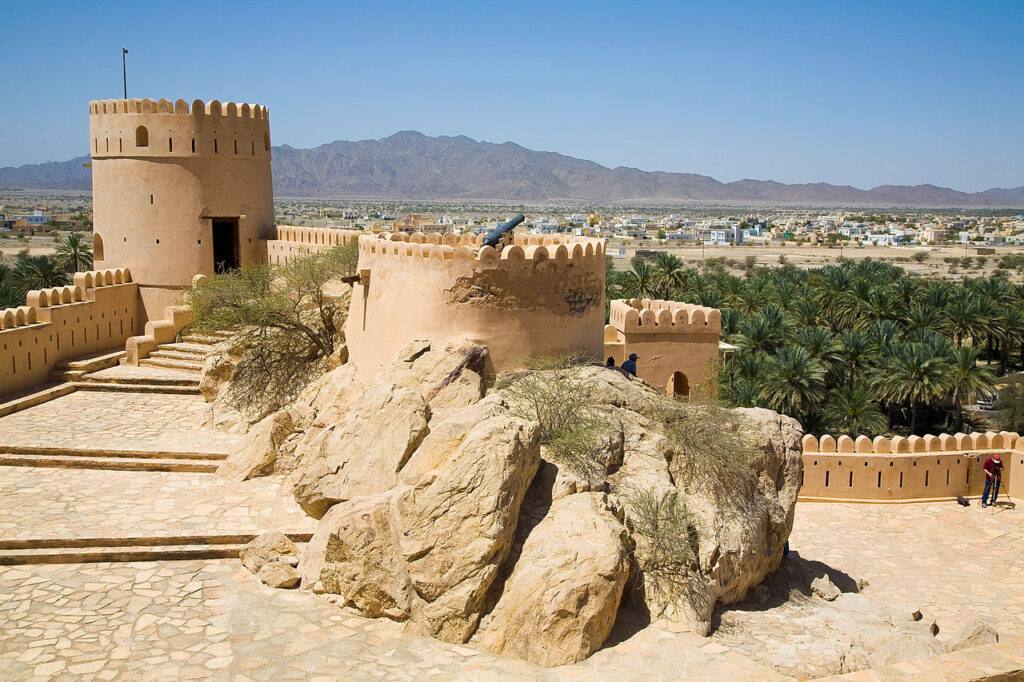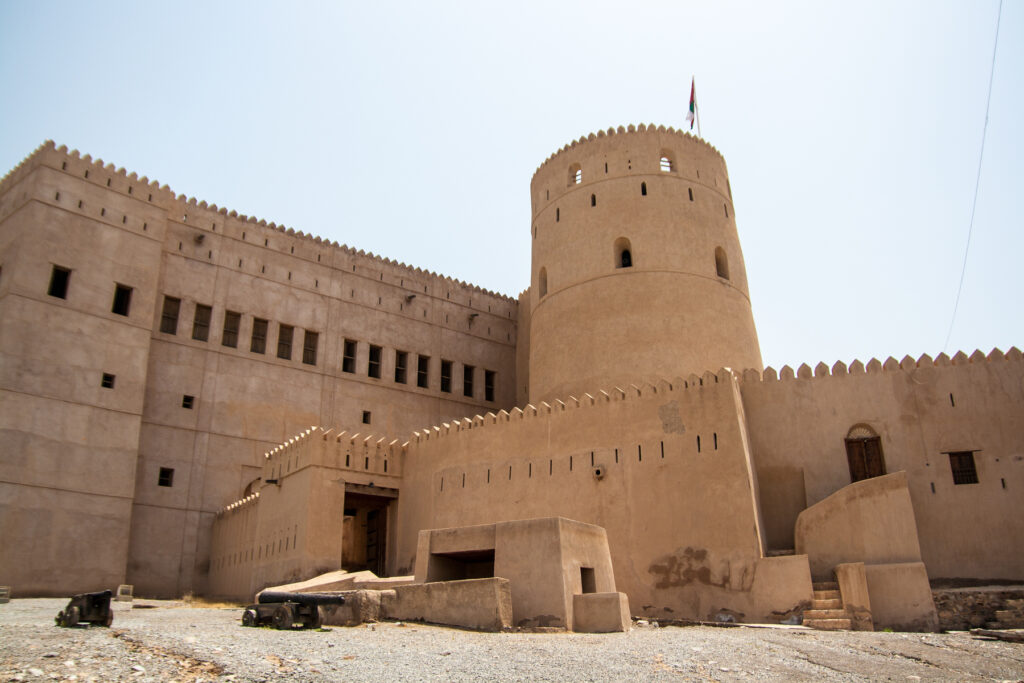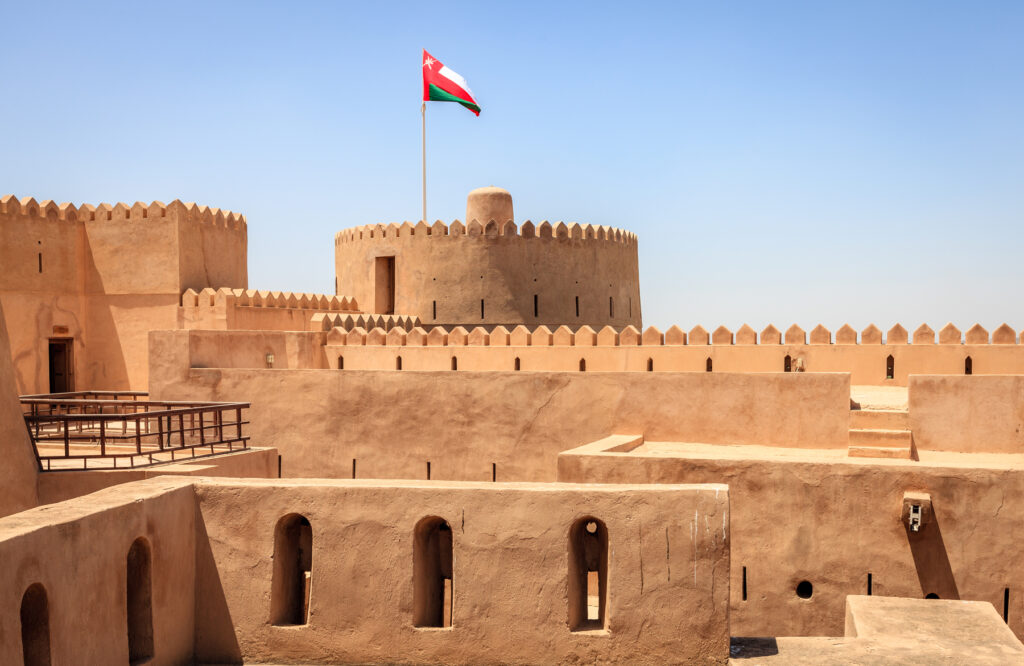The Rustaq Loop is an inland circuit that travels via Nakhal, Ar Rustaq and Al Hazm, three of Oman’s finest forts. There are several magnificent wadis close to this route too. Each of the three major forts takes at least an hour to visit, so set aside a day, or ideally two, for the round trip. You can flag down local taxis anywhere on this route to reach the main towns on the tarmac, but to head into the wadis you need your own transport, preferably 4×4 to really make the most of these.
Nakhal Fort
Built to protect the oasis at Nakhal and trade routes through to the coast, this fort was enlarged several times over the centuries. It is believed to be Sassanid in origin; the water well in the fort’s highest section is possibly from that era. The fort was restored in 1990, changing the colour from well-worn grey to the standard Omani fort khaki, at which time rooms were also labelled and furnished with crafts and antiquities.
From a distance, Nakhal Fort is dwarfed by the mountainous backdrop, but the closer you get, the more impressive it becomes – it is probably the most photogenic of Oman’s forts. The fort has a number of bastions and towers, with walls that follow the natural contours of the rocky outcrop on which it sits.

Entering through the gate built in 1834, you pass through a couple of additional entrances on the way up to the keep. The date stores, always present in Oman’s forts, are passed en route. A barzah, the reception room used by the governor for regular meetings, is in the upper area. Its windows catch slight breezes coming from the sea. At both the western and eastern edges of the castle bailey (courtyard) is a round tower.
The keep (upper area of buildings), again entered through a gate, were the private rooms and living accommodation of the governor’s family. This is the most charming area, furnished with cushions and ornaments, and with a guest room boasting a decorated ceiling.
Ar Rustaq Fort
Sitting at the northern base of Al Jabal Al Akhdar and still dominating the town today, Ar Rustaq Fort is said to have been founded before the arrival of Islam in Oman, making it one of the country’s oldest. Its original name is Qalat Al Kusra (Kusra’s Fort), possibly referring to Khusraw Anushirvan (Khosrow I), the Sassanid ruler who died in 579 AD. The second Yarubi imam moved his capital here from Bahla and started a rebuild of the fort. Subsequent rulers from this dynasty continued to have Ar Rustaq as their capital.
With such an extended history, it’s not surprising that the fort itself has a complicated layout. After making payment at the gate in the curtain wall, you enter the bailey, which entirely surrounds the fort. After rain the west side may have flowers and butterflies. An old falaj system, whose water still flows strongly and is warm, runs from here into the building. The castle inhabitants used to collect this water in pottery jars and hang it in a shady place to cool, after which it could be drunk.

Inside the fort few rooms are signed and, given that it has had many additions over the centuries, it is somewhat disorienting, to the extent that you may not be certain of seeing all that there is to see. On the ground floor of the fort are prison cells, stores and an armoury. The most decorated rooms, with painted dark red and white ceilings, are the imam’s rooms, located on the first floor, immediately above the fort’s entrance door. The central beam on the ceiling carries Quranic inscriptions listing some of the 99 attributes of God, such as the King, the Wise and the Holy. Another noteworthy spot, near this room, is the tiny women’s mosque, barely big enough for two to enter, with its minute mihrab to the left.
The highest tower of all is in the southwest of the fort, accessed up an ancient flight of stairs. This is the oldest part of the fort, the core that is possibly Persian in origin. Without any windows it was clearly built for defence rather than comfort. You can carefully walk along the parapet around the courtyard, giving you superb views over the oasis.
Al Hazm Fort
Your first sight of Al Hazm Fort is its battlements peering over the scattered date palms in Al Hazm village. The date given for its building, by Sultan bin Saif Al Yarubi, is 1708 (he would become ruler in 1711), and it is a superb example of Omani Islamic architecture. Its exterior is plain, even a little disappointing, although once you are close up its scale more than compensates. In Arabic ‘Al Hazm’ has a meaning ‘the vanquishing one’ and when you have completed your tour you will understand why the fortress was never captured. Opposite the entrance gate, behind some small shade trees, is the office for payment. You may be fortunate and, if you ask, the fort’s guide might show you around the building.
Impressive doors with elegant arabesque decoration and wonderful ‘elephant spikes’ provide the entrance; included in their decoration is the date that they were made, April from this floor; clearly the architect built in anticipation of hard, closely fought attacks. The next floor includes the entrances to the two massive gun towers, on diagonally opposite corners of the building.

The southeast tower houses British iron cannons, including one from 1630, a period when cheaper iron cannons with their superior firepower were being produced by Britain. A secret passageway links the east and west towers. This passageway is the coolest place in the fort, as it is set between the first and ground floors, with massively thick walls, its only connection to the outside world being some small ventilation holes. There are also secret passages leading outside.
The roof gives extensive vistas north across the plain towards the coast and south towards Jabal Shams, some 40km away, high above the mountains over Ar Rustaq.